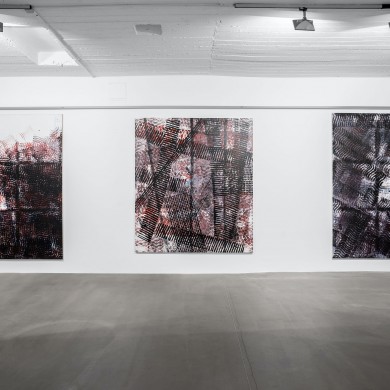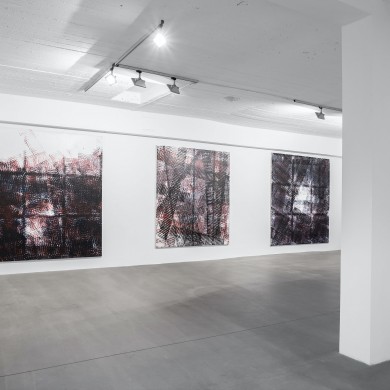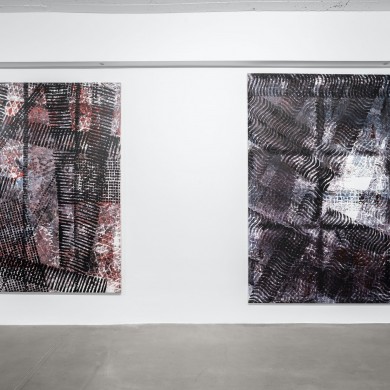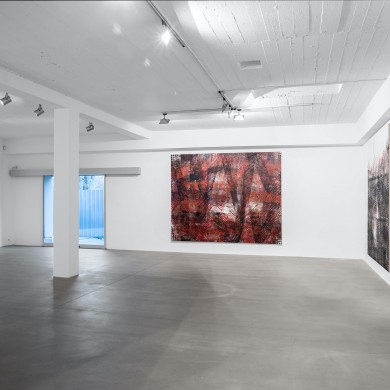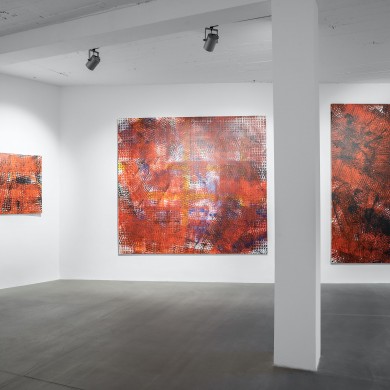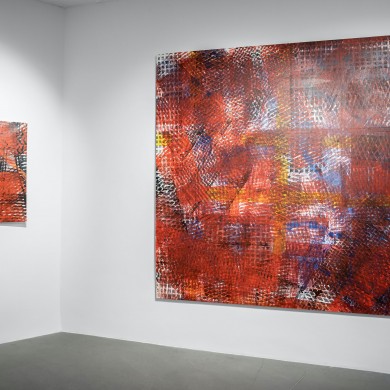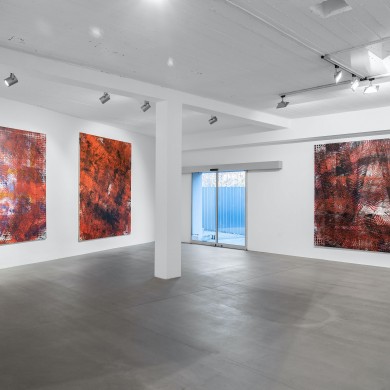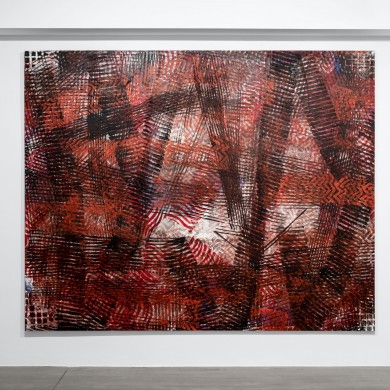Vladimír Ossif
kurátorka: Zuzana Bartošová
vernisáž: 4.11. 2021, 19:00
trvanie výstavy do 2. decembra 2021
ZAHORIAN & VAN ESPEN Bratislava
Ako osobnosť je Vladimir Ossif typ nomáda. Jeho vášňou však nie je cestovanie, hoci by sa to mohlo zdať. On túži zotrvať na miestach, ktoré sa mu páčia, kde sa dobre cíti, ku ktorým má hlbší vzťah. Tam chce ostať. Žiť a tvoriť. Byť niekým, kto tam patrí. Pri spätnom pohľade je pre neho Paríž, Madrid, Ortaffa, ale aj Bratislava, New York či Havana domovom. Predpokladom pre optimálne zvládnutie presunov medzi týmito mestami a zabývanie sa v nich, je jeho nesporná sociálna inteligencia. Ale nielen ona. Predovšetkým presvedčivosť jeho maliarskej tvorby je mostom, ktorý mu otvára dvere, priestory a možnosti na predtým nepoznaných miestach.
Ako neznámy emigrant v Paríži, bez finančných prostriedkov, sa Vladimír Ossif dokázal o seba postarať. Na Ecole nationale supérieure des arts decoratifs si doplnil aj rozšíril vedomosti a obzory, ktoré predtým získal na Vysokej škole výtvarných umení v Bratislave. Už v roku 1985, keď končil svoje štúdium, vyšla kniha mladej parížskej kritičky Geneviève Bénamou Sensibilitées contemparaines. 70 artistes d´origine tchèque et slovaque hors Tchécoslovaquie 1970‒1984 (Súčasné senzibility. 70 pôvodom českých a slovenských umelcov mimo Československa 1970 – 1984), ktorá sa o výtvarnú tvorbu umelcov v Československu zaujímala už koncom sedemdesiatych rokov. Po publikovaní svojho výskumu v ateliéroch umelcov Prahy, Brna a Bratislavy (L´Art aujourd´hui en Tchécoslovaquie / Súčasné umenie v Československu, Paríž 1979) sa aj naďalej venovala sledovaniu osudov maliarov, sochárov a grafikov pochádzajúcich vtedy ešte zo spoločnej republiky žijúcich v emigrácii. S pomocou výberu textov od mnohých autorov i samotných umelcov podala zasvätený pohľad na tvorbu viacerých významných českých a slovenských autorov. Do tohto kontextu zaradila aj tvorbu Vladimira Ossifa. V jeho ranej tvorbe ju zaujalo najmä stvárnenie svetla. Gérard Barrière videl okrem neho „v niektorých plátnach chvejúce sa náznaky kryštálov“ (1988).
Ossifovej tvorbe sa v priebehu času venovali aj ďalší významní kritici umenia, ako francúzski, tak slovenskí. Henri-François Debailleux upozornil na zmenu jej tvaroslovia, ktoré nazval „pružnou geometriou“, pričom „od plátna k plátnu, ba aj v rámci každého z plátien sa tvary menia, pohrávajú sa s vlastnými obrysmi a s usilujú, aby boli viac-menej neurčité…“ (1993). Ján Abelovský ocenil Ossifovu „schopnosť údivu… nad duchovným rozmerom triviality“. A konštatoval, že v svojich obrazoch využil „zostup k elmentárnemu“ tvarosloviu, k „prostej ikonografii… základných geometrických obrazcov… a zdržanlivú farebnosť.“ (1996). Pascal Bonafou upozornil na „naliehavosť“ Ossifových kompozícií, ku ktorých pochopeniu divák potrebuje „dostatok času, aby za uhlami a krivkami, ktoré sa pnú, lámu a trieštia“ rozpoznal ich podstatu (1996). Zora Rusinová konštatovala v umelcovej zrelej tvorbe nástup „koordinovaného systému znakov“ a vyzdvihla jeho „zmysel pre tektonickú výstavbu obrazového priestoru“. Spôsob jeho maľby dala do súvislosti s „fenoménom francúzskej maľby support surface“ (2006). Sám Vladimir Ossif v rozhovore so Silviou van Espen na jej otázku o súvislosti abstraktnej geometrie a jej možnou inšpiráciou New Yorkom, priznáva fascináciu týmto mestom, jeho ulicami, verejným životom vrátane „sprejového sveta, ktorý je tu všade prítomný“(2011).
Od týchto charakteristík Ossifovej tvorby ubehol pomerne dlhý čas. Spätný pohľad ňu z pozície tej aktuálnej, ktorú prezentuje súčasná výstava, umožňuje hľadať spoločného menovateľa jej meniacej sa podoby. Odhliadnuc od raných diel, v ktorých rezonovala štrukturálna maľba, transparentnosť farebných plôch a neskôr obdiv k Miróovi a Tàpiesovi, možno v celej nasledujúcej vnímať postupný prerod k abstraktnej geometrii. V jej uvoľnenej podobe čoraz viac vystupuje do popredia umelcovo očarenie fenoménom mesta, k čomu sa i sám priznal. Pritakanie jeho dynamike, urbanizmu celku i geometrickým súradnicam architektúr a ich detailov. Hravé kombinovanie a striedanie uhlov pohľadu stvárňovania prvkov, ktoré by mohli evokovať realitu podčiarkuje jeho chuť zotrvať v anonymite znakovej abstrakcie.
Veľkorozmerné obrazy, ktoré vo svojej výške niekedy dosahujú viac ako tri metre, Vladimir Ossif vytvára, vodorovne, na dlážke svojho ateliéru, ako to má od svojich začiatkov vo zvyku. Rovnako pracovali aj umelci skupiny Supports/ Surfaces. Na tento „fenomén francúzskej maľby“ rezonujúci v Ossifovej tvorbe upozornila už Zora Rusinová. Možno upresniť, že ide o konkrétne autorské zoskupenie, ktoré s uvedeným názvom pôsobilo od konca šesťdesiatych rokov. Jeho členovia priznali inšpiráciu talianskym Arte Povera a parížskym Novým realizmom. Zároveň však svojou tvorbou potvrdili význam maľby v čase jej maximálneho spochybnenia.
Aj z tohto stanoviska, ktoré je Ossifovi zrejme mentálne blízke, možno vysvetliť jeho vernosť obrazovým kompozíciám. V nich hrá proces maľby, a to všetkými dostupnými technikami a nástrojmi, či už ide o štetec, špachtľu, alebo odtlačky valčekov, ako je to na prítomných kompozíciách, dôležitú úlohu. Nimi umelec vytvára stopy v imaginárnom dynamickom priestore plátien. Ten vzniká ich stretmi, krížením a prekrývaním. Napriek svojmu abstraktnému charakteru kompozície evokujú asociácie na industriálne krajiny, ktoré pretínajú odtlačky pneumatík áut, či drôtené pletivá plotov.
Relatívne novým fenoménom Ossifovej tvorbe je asketická farebnosť. Dominuje monochrómnosť čiernych stôp na bielom či ešte beľšom podklade, často spochybnenom transparentnými sivými alebo sivomodrými plochami. Odtlačky valčekov priamej červenej alebo terakotovej farby a segmenty oválov sieny pálenej, či vznášajúce sa neurčité ovoidy porcelánovo modrej, tiež kráľovskej fialovej, podčiarkujú hĺbku kompozícií. Slobodomyseľnú farebnosť a tvarovú hravosť, ktorá komunikovala umelcov optimizmus predošlých období jeho tvorby, vystriedali jednoznačné veľkorysé gestá. Tlmočia nevšednú životnú energiu, ktorá rezonuje s dynamikou jeho vlastného života. / Zuzana Bartošová
Vladimír Ossif, (*1954, Prešov). 1974-1980 štúdium na Vysokej škole výtvarných umení v Bratislave, 1982 emigrácia z Československa do Francúzska, 1983-1985 štúdium na Ecole nationale supérieure des arts decoratifs v Paríži. 1984-1986 rezident Cité internationale des arts v Paríži, 1989-1991 rezident Casa Velasquez v Madride. 1991 ateliér v Ortaffe (oblasť Katalánska v južnom Francúzsku). 1995-1996 pobyt v New Yorku.0d 1997 ateliér v Bratislave. 2008-2011tvorivé pobyty v New Yorku a v Paríži. Od 2014 paralelný ateliér v Havane na Kube. Samostatné výstavy: Kolín nad Rýnom, Paríž, Mühlbach, Madrid, Bratislava, Košice, Ceret, Praha, Opole, Krnov, Norimberg, Budapešť, Mníchov, Nitra, Berlín, Viedeň, Trnava, Poprad, Zvolen, Banská Bystrica, New York (vo viacerých mestách opakovane). Skupinové výstavy: Montrouge, Kolín nad Rýnom, Paríž, Madrid, Ženeva, Praha, Prešov, Pau, Malorca, Madrid, , Saint Etienne, Ceret, Bratislava, Norimberg, Dolný Kubín, Košice, Banská Bystrica, Krasiczinie, Oradea, Debrecín (vo viacerých mestách opakovane).
Projekt podporil z verejných zdrojov Fond na podporu umenia![]()
Vladimír Ossif
curated by Zuzana Bartošová
opening 4 Nov, 7 pm
duration until 2 Dec 2021
ZAHORIAN & VAN ESPEN Bratislava
As a person, Vladimir Ossif is a kind of nomad. But travelling is not what he passionately loves, though that might seem to be the case. He longs to remain in the places he likes, where he feels well, places he has a deep affinity with. There he wants to stay. To live and create. To be someone who belongs there. Looking back, for him Paris, Madrid, Ortaffa, and equally Bratislava, New York and Havana, have been home. A prerequisite for an optimal mastery of the moves between these cities and residing in them, is his undeniable social intelligence. But not that alone. It is above all the persuasiveness of his painting that is the bridge for him, opening doors, spaces and opportunities in previously unknown places.
As an unknown emigrant in Paris, without financial means, Vladimír Ossif managed to take care of himself. At the Ecole nationale supérieure des arts decoratifs he widened his horizons and perfected the knowledge he had previously acquired at the Academy of Fine Arts and Design in Bratislava. As early as 1985, when he was finishing his studies, a book appeared by the young Parisian critic Geneviève Bénama, Sensibilitées contemparaines. 70 artistes d´origine tchèque et slovaque hors Tchécoslovaquie 1970‒1984 (Contemporary Sensibilities. 70 Artists of Czech and Slovak Origin Outside Czechoslovakia 1970 – 1984). Previously, in the late 1970s, Benama had taken an interest in what visual artists in Czechoslovakia were then producing. After publishing her researches in the studios of artists in Prague, Brno and Bratislava (L´Art aujourd´hui en Tchécoslovaquie / Contemporary Art in Czechoslovakia, Paris 1979), she had gone on to study the fate of painters, sculptors and graphic artists who came from what was then still the united republic but were living in emigration. Using a selection of texts by many authors and by the artists themselves, she offered an initiate’s view of the work of several important Czech and Slovak artists. She included Vladimir Ossif’s work in this context. In his early work he was interested especially in the portrayal of light. Gérard Barrière saw, besides that, “trembling hints of crystals” in some of his canvases (1988).
With the passage of time some other prominent art critics, Slovak as well as French, engaged with Ossif’s art. Henri-François Debailleux pointed to a change in its morphology, which he called “a supple geometry”, given that “from canvas to canvas, or indeed within each canvas individually, the shapes change, playing about with their own contours and striving to become more or less indefinite…” (1993). Ján Abelovský acknowledged Ossif’s “capacity for wonder… at the spiritual dimensions of triviality”. He went on to say that in his paintings Ossif employed “a descent towards elementary” morphology, “to the simple iconography… of basic geometrical schemas… and a restrained colour” (1996). Pascal Bonafou drew attention to the “urgency” of Ossif’s compositions, for comprehending which the viewer needed “plenty of time, so as behind those angles and curves that twist, break and splinter” to identify the essential (1996). Zora Rusinová declared that “a coordinated system of signs” came into play in the artist’s mature work, and she praised his “sense of the architecture of the pictorial space”. She saw his mode of painting as connected with “the phenomenon of French support surface painting” (2006). Vladimir Ossif himself, in an interview with Silvia van Espen, when asked about connections with abstract geometry and its possible inspiration by New York, admitted that he was fascinated with that city, its streets and its public life, including “the spray world… which is present everywhere here” (2011).
A relatively long time has passed since Ossif’s work was characterised in these terms. Looking back on it from the standpoint of his present-day work, as presented in the current exhibition, we are enabled to find the common denominator in its mutating form. Leaving aside the early works, with their notable resonances of structural painting, transparency of the colour surfaces, and subsequently admiration for Miró and Tàpies, in all that follows one can detect a gradual transmutation towards abstract geometry. In its relaxed form, the artist’s enchantment by the phenomenon of the city (and he himself has acknowledged this) comes ever more to the forefront. Affirmation of its dynamics, the urbanism of the whole, and the geometrical coordinates of building complexes and their details. The playful combination and alternation of angles of vision in the depiction of elements that might evoke a reality: all of this underlines his desire to remain in the anonymity of signifying abstraction.
Vladimir Ossif creates his large-format paintings, which are sometimes over three metres high, horizontally on the floor of his studio, as he has customarily done from the beginning. The artists of the Supports/ Surfaces group used to work in the same way. Zora Rusinová has already highlighted this “phenomenon of French painting” that resonates in Ossif’s work. More precisely, one may say that there are echoes of a specific group of artists, the above-mentioned Supports/Surfaces, who were active from the late 1960s. Its members took inspiration from Italian Arte Povera and Parisian New Realism. At the same time, however, their art reaffirmed painting, at the point when its significance was most doubted.
From this standpoint also, which is evidently close to Ossif’s thinking, one may explain his loyalty to pictorial compositions. The process of painting plays an important role in them, employing all available technologies and instruments, whether it be brush, palette knife, or (as in the present compositions) roller impressions. Using these, the artist creates traces in the imaginary dynamic space of the canvases. That space emerges via their encounters, crossings and overlaps. Despite their abstract character, the compositions evoke associations of industrial landscapes, cut across by the imprints of car types and the meshes of wire fences.
A relatively new phenomenon in Ossif’s work is ascetic colouring. There is a predominating monochrome of black traces on a white or still whiter base, which is often put in question by transparent grey or grey-blue passages. Roller impressions of a plain red or terracotta colour, and segments of ovals in burnt sienna, or uncertainly hovering ovoids of porcelain blue and some of royal violet, underline these compositions’ depth. A free-thinking colourfulness, and the playful shape-making that communicates the artist’s optimism in the most recent periods of his work, have replaced unambiguous grand gestures. They convey an uncommon vital energy, which resonates with the dynamics of the artist’s own life. / Zuzana Bartošová
Vladimír Ossif (*1954, Prešov). 1974-1980 studied at the Academy of Fine Arts and Design in Bratislava; 1982 emigrated from Czechoslovakia to France; 1983-1985 studied at Ecole nationale supérieure des arts decoratifs in Paris. 1984-1986 resident Cité internationale des arts in Paris; 1989-1991 resident Casa Velasquez v Madride. 1991 studio in Ortaffa (Catalan region in southern France). 1995-1996 resided in New York. From 1997 studio in Bratislava. 2008-2011 creative residencies in New York and Paris. From 2014 parallel studio in Havana. Solo exhibitions: Köln, Paris, Mühlbach, Madrid, Bratislava, Košice, Ceret, Prague, Opole, Krnov, Nuremberg, Budapest, Munich, Nitra, Berlin, Vienna, Trnava, Poprad, Zvolen, Banská Bystrica, New York (more than one exhibition in several). Group exhibitions: Montrouge, Köln, Paris, Madrid, Geneva, Prague, Prešov, Pau, Malorca, Madrid, Saint Etienne, Ceret, Bratislava, Nuremberg, Dolný Kubín, Košice, Banská Bystrica, Krasiczinie, Oradea, Debrecín (more than one exhibition in several).
